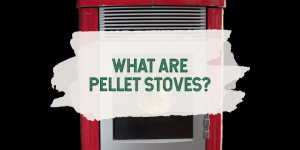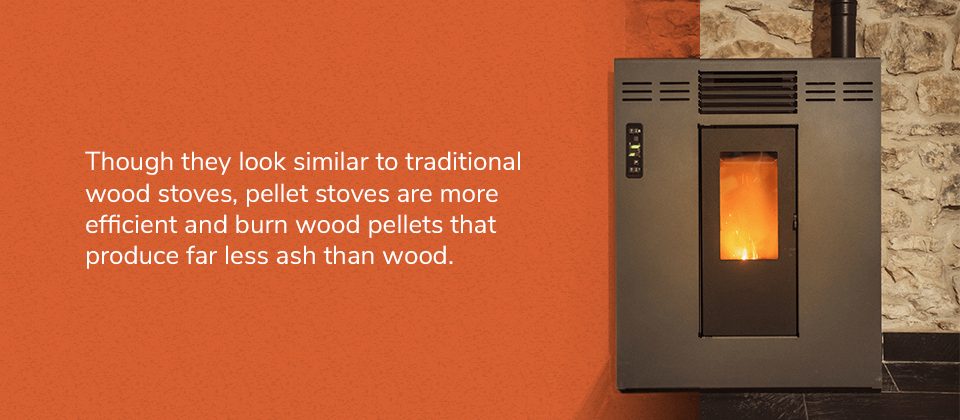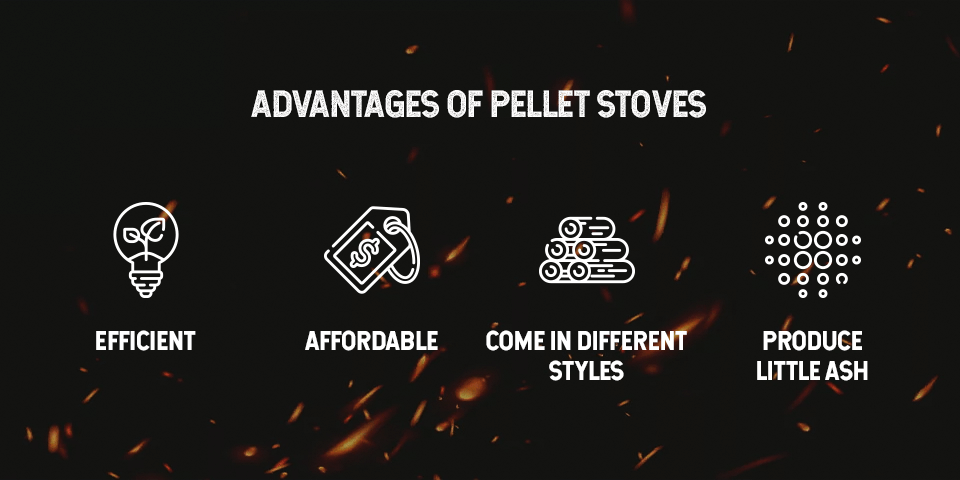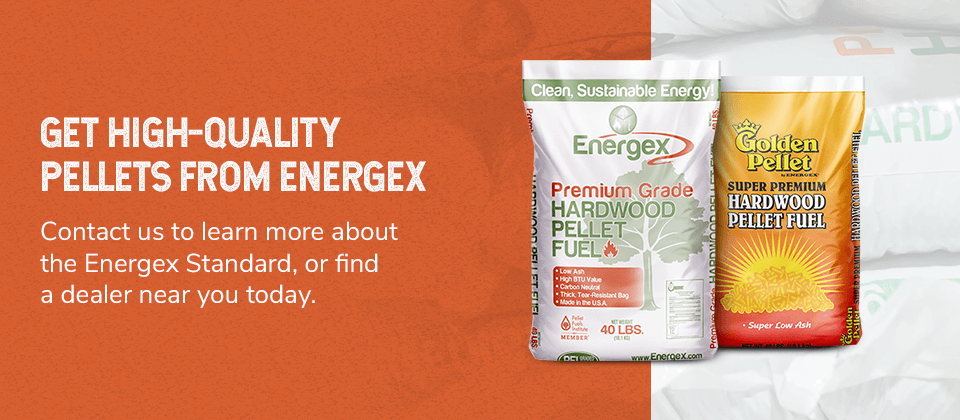What Are Pellet Stoves?

Pellet stoves are a home heating method that is easy to operate, stylish and both cost and energy-efficient. Compared to other forms of home heating, pellet stoves are also cleaner, safer and more eco-friendly. Read on to learn more about the benefits of pellet heating and see why making the switch could be the right choice for you.
What Are wood Pellet Stoves?
Pellet stoves are freestanding heating stoves or stove inserts that you can use to heat a single room or your entire home. Though they look similar to traditional wood stoves, pellet stoves are more efficient and burn wood pellets that produce far less ash than wood. According to the Department of Energy, they are the cleanest form of residential heating that uses solid fuel. You can use a pellet stove to maximize your existing home heating system, or you can use it as your sole heat source.

When choosing your pellet stove, always consider the size and layout of your home and size your stove accordingly. If your stove is too big, you risk wasting fuel. If it’s too small, you won’t enjoy the efficient heating that pellet stoves are known for. In some cases, you may want more than one pellet stove for optimal comfort. You also need to be mindful of where you install your stove in a room and work with a professional installer to choose the best location for maximum efficiency.
How Does a wood Pellet Stove Work?
Pellet stoves are simple to use because their design is straightforward. Every pellet stove utilizes the same basic components, including a hopper, pellet feeding system, burn and ash pots and a blower and exhaust system. Some pellet stoves have built-in control systems, while others require manual operation.
Each part of a pellet stove works together to burn and distribute heat from wood pellets. This is how it works:
- Pellet storage: To minimize mess and save time, store your pellets near your pellet stove. Choose a storage container that is airtight and waterproof to keep your pellets dry. Never add new pellets to a container full of old ones. Instead, do not refill the container until all the old pellets are gone, or have two separate containers for old and new pellets.
- Hopper: The hopper is the part of a pellet stove — either on the top or bottom of the unit — that holds between 35 and 130 pounds of pellets until they are ready to be burned. You will usually load your hopper once per day, maybe more or less often depending on the size of your unit and the frequency at which you burn pellets.
- Auger: The auger is a screw-like feeding device that removes a few pellets from the hopper at a time and moves them into a combustion chamber, where it deposits them into the burn pot. The faster the auger operates, the stronger the pellet stove heat output.
- Burn pot: Once in the burn pot, the pellets ignite and create a hot flame.
- Ash pot: As pellets burn in the burn pot, they produce minimal ash. The ash pot collects this ash for you to clean out and dispose of later.
- Blower: While all of this is happening inside the unit, the blower system pulls in cooler air from the room and moves that cold air over the hot flames inside the burn pot. This strengthens the flames, creating an even, long-lasting burn.
- Heat exchanger: As the burn pot burns the pellets and produces heat, it moves across an exchanger and into the blower, where it is expelled into the surrounding room. Thanks to the ash pot, this warm air is also clean. This process helps the external parts of the heating stove remain at a safe temperature.
- Exhaust pipe: Unlike most wood stoves and fireplaces, you do not need an entire chimney system to operate a pellet stove safely. All you need is an exhaust pipe or tube connecting the blower to a small rooftop chimney fixture or through the wall behind the stove. A professional installer can help you choose the right exhaust method for your home layout and stove type.
- Thermostat: Some stoves have a digital control system with a thermostat that allows you to have full control over how many pellets the auger distributes at a time, thus controlling the total heat output of your unit.
Are wood Pellet Stoves Worth It?
With correct maintenance, a pellet stove is a worthwhile investment for your home. Compared to oil and propane, pellet stoves are more eco-friendly, affordable and convenient. The average homeowner uses only two to three tons of fuel each year, and pellets require no chopping or complicated storage. If you have multiple stoves or require large quantities of pellets and live near a pellet distributor, you can have bulk orders delivered to your home or business.

What are the Advantages of Pellet Stoves?
Once installed correctly and fueled with high-quality heating pellets, a pellet stove will keep your room or house warm all winter long. Additional benefits of a pellet stove include:
- Pellet stoves are efficient: The pellet stove heating efficiency of an EPA-certified unit is between 70% to 83%. Pellet stoves also have a heating range between 8,000 Btu and 90,000 Btu every hour.
- Pellet stoves are affordable: Pellet stoves are cheaper to install than wood stoves, and some states offer tax rebate incentives when you choose a pellet stove over other heating systems.
- Pellet stoves come in different styles: You can find pellet stoves in various sizes, styles and colors to suit any interior design or decorating theme.
- Pellet stoves produce little ash: Wood stove ash and buildup can cause blockage and chimney fires and can be a challenge to keep clean. Pellet stoves produce minimal ash, which makes them a cleaner and safer heating system for your home. You can even repurpose pellet stove ash for biofuel projects, like fertilizer, architectural materials or to aid in seed germination and growth.
The Importance of a Quality Heating Pellet
Heating pellets are small cylinders of compressed, recycled sawdust and other wood materials. They are a renewable and eco-friendly home heating solution. Like other types of fuel, different manufacturers produce different qualities of pellets. High-quality heating pellets are an essential part of pellet stove success. The better quality heating pellet you use, the safer and more efficient your stove will be.
A quality heating pellet will be uniform in size, typically 6 millimeters to 8 millimeters in diameter. Moisture content should be low for a long-lasting burn — ideally between 5% and 10%. One way to test wood pellets for excessive moisture is to note how much dust is in the bottom of the bag. In an average-sized 40-pound bag, there should be no more than one-half cup of dust. Look for pellets with 0.7% ash or less and with no binding agents or adhesive additives.
A great way to determine the quality of a wood pellet is to look for a Pellet Fuels Institute (PFI) Quality Mark on the front of the bag. PFI is a third-party accreditation program with strict quality standards for residential and commercial heating pellets. Every bag of Energex heating pellets is PFI certified.

Get High-Quality Pellets From Energex
Pellet stoves are a good way to keep your house warm, cut costs and do your part to create a cleaner world. When you purchase softwood or hardwood heating pellets from Energex, you’re investing in a high-quality, premium-grade product backed by a PFI Certification and hours of rigorous testing. Contact us to learn more about the Energex Standard, or find a dealer near you today.

